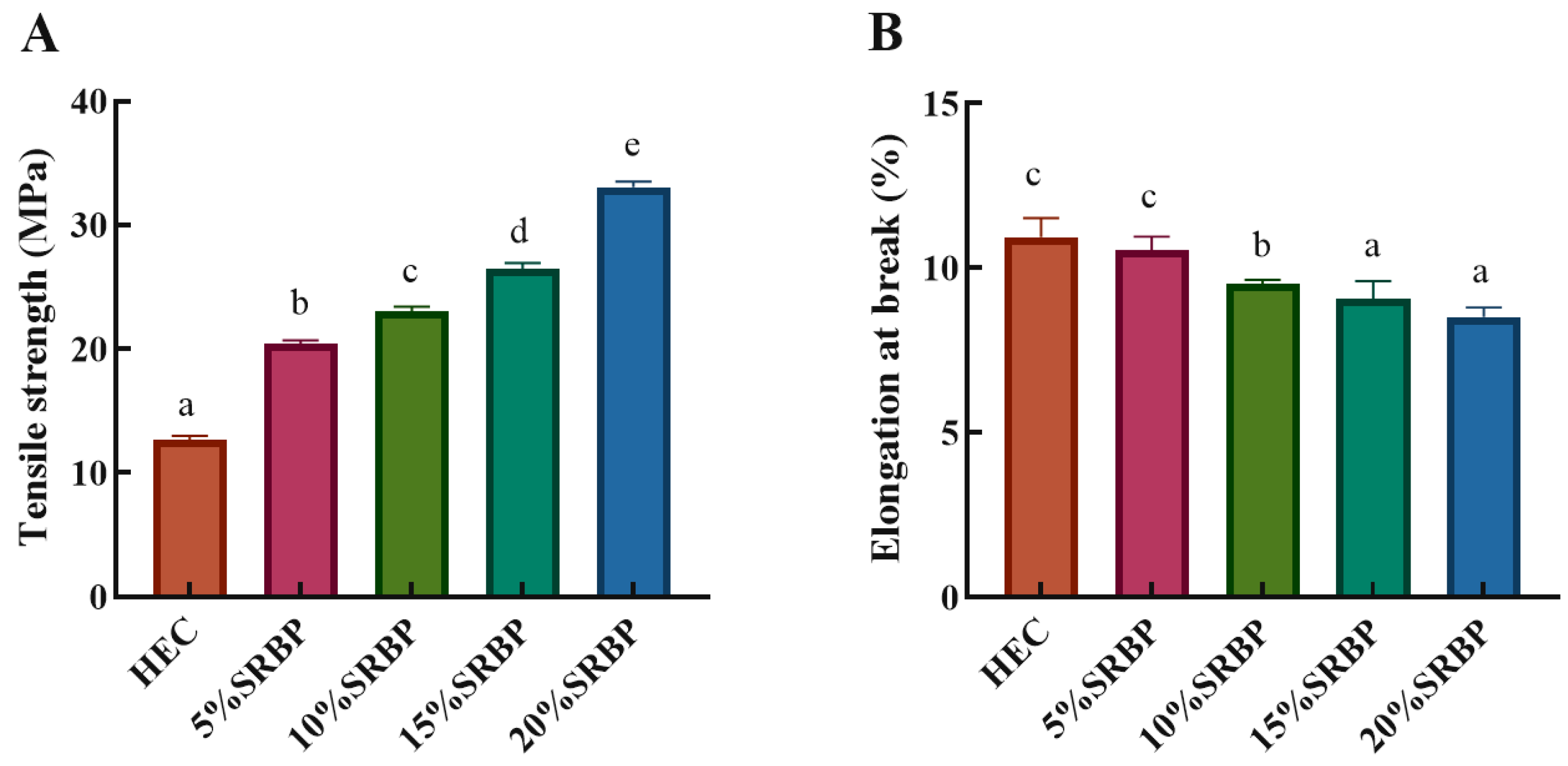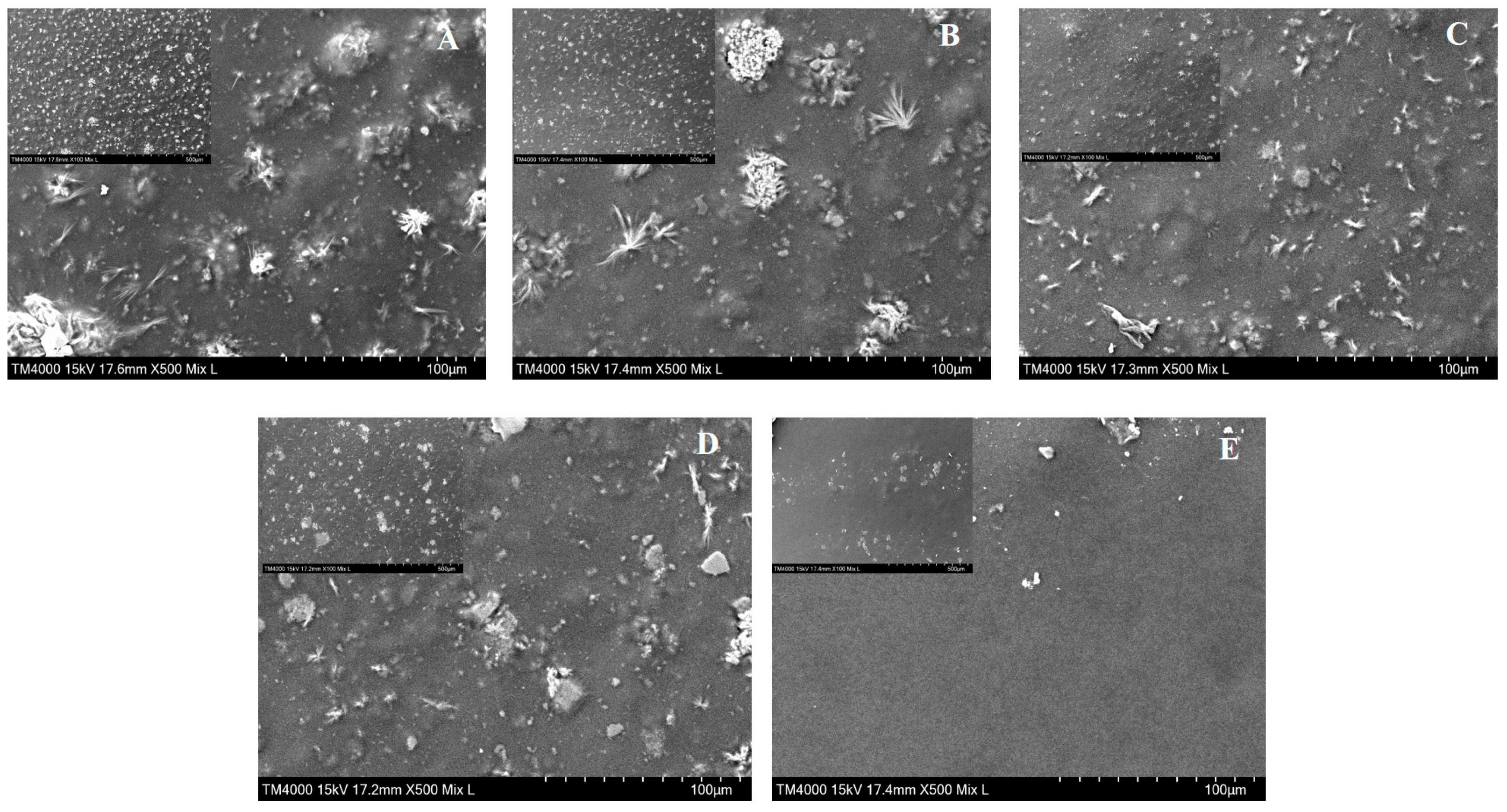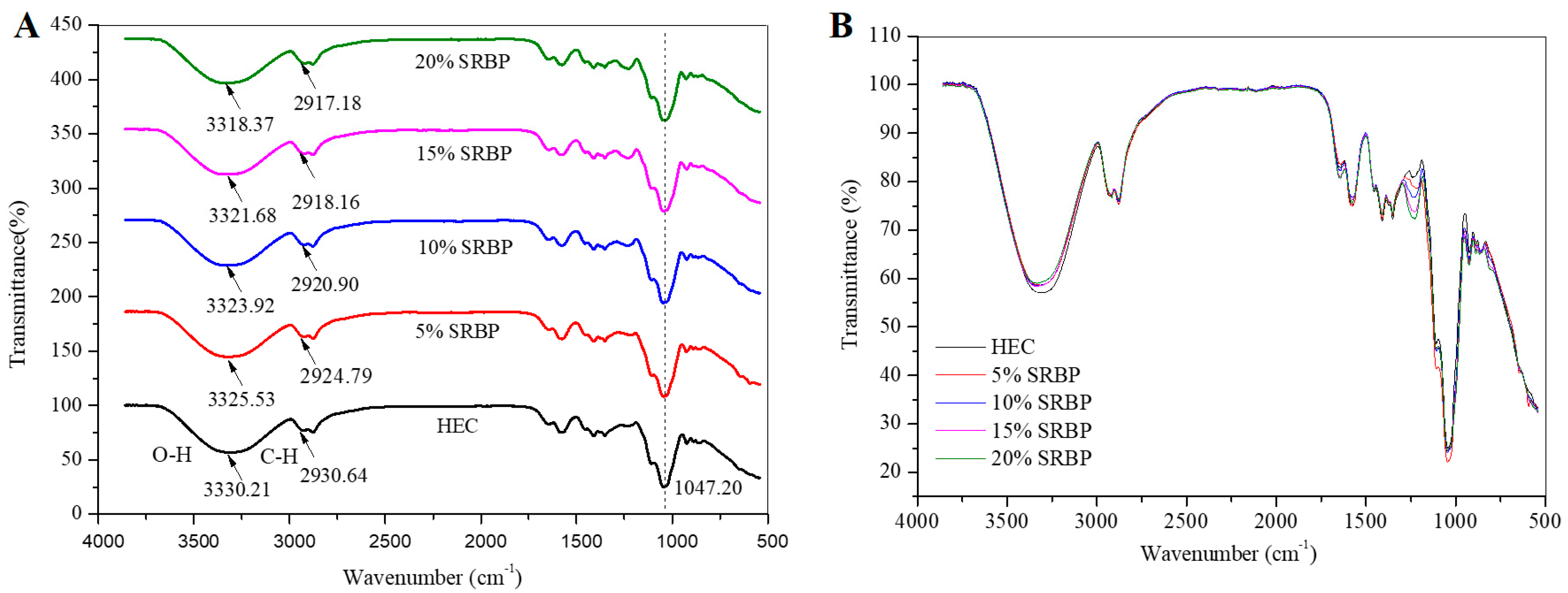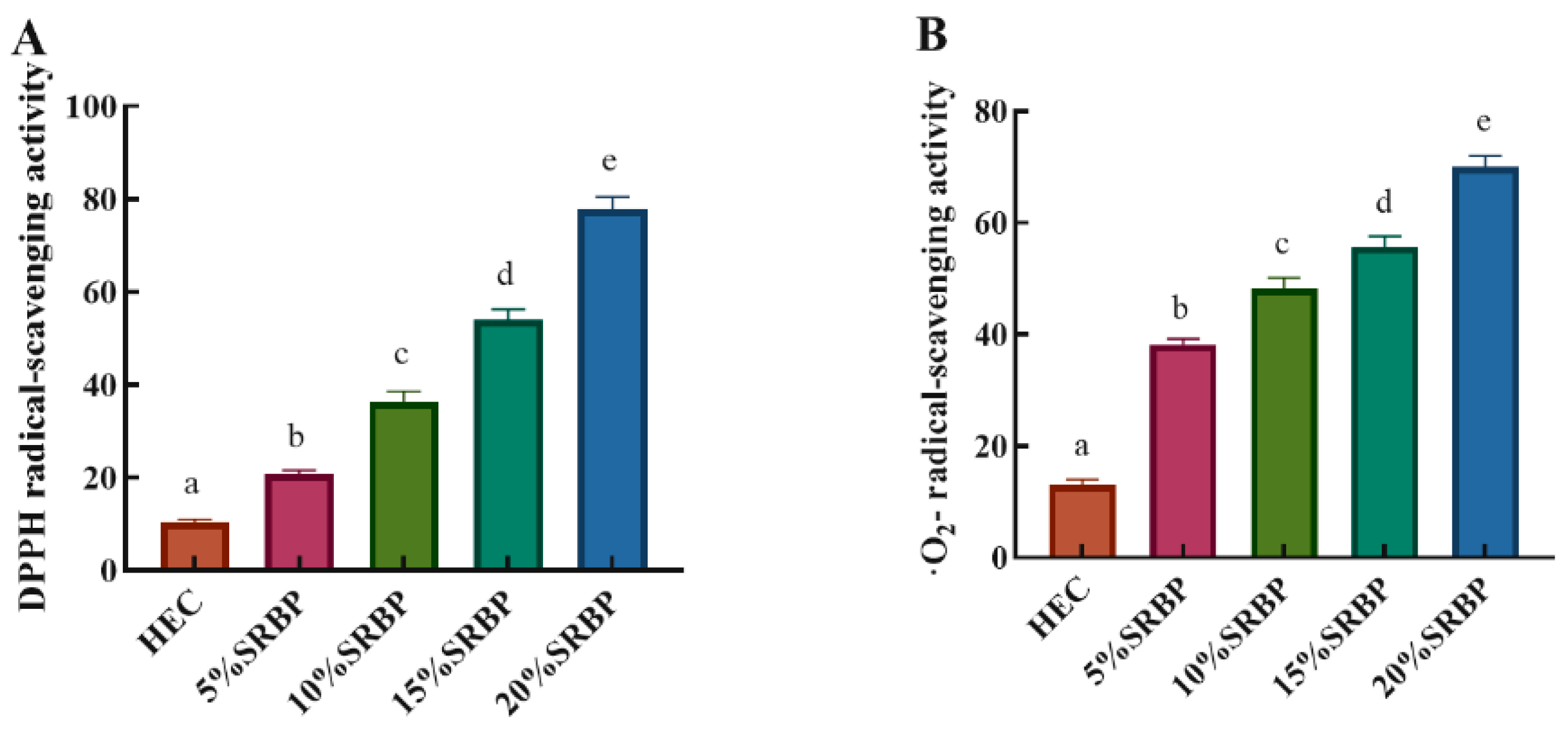Development and Characterization of an Antioxidant and Antimicrobial Film Composited by Hydroxyethyl Cellulose and Sulfated Rice Bran Polysaccharides for Food Packaging
Abstract
1. Introduction
2. Materials and Methods
2.1. Materials
2.2. Preparation of RBP
2.3. Preparation of SRBP
2.4. Preparation of the Composite Film
2.5. Physical Characteristics of Films
2.5.1. Thickness
2.5.2. Moisture Content and Water Solubility
2.5.3. Water Vapor Permeability (WVP)
2.5.4. Color Property and Transparency
2.5.5. Mechanical Properties: Tensile Strength (TS) and Elongation at Break (EB)
2.5.6. Morphological Characteristics
2.5.7. Fourier Transform Infrared Spectrometry (FT-IR)
2.6. Thermodynamic Analysis
2.7. Antioxidant Activities of the Films
2.7.1. 1,1-Diphenyl-2-picrylhydrazyl (DPPH) Radical Scavenging Activity
2.7.2. Superoxide Anion Radical (O2−) Scavenging Activity
2.8. Antibacterial Activity
2.9. Statistical Analysis
3. Results
3.1. Physical and Mechanical Properties of Films
3.2. Color Characteristics
3.3. Mechanical Properties
3.4. SEM
3.5. FT-IR
3.6. Thermodynamic Analysis
3.7. Activity
3.7.1. Antioxidant Activity
3.7.2. Antibacterial Activity
4. Conclusions
Author Contributions
Funding
Institutional Review Board Statement
Informed Consent Statement
Data Availability Statement
Conflicts of Interest
Abbreviations
| Abbreviation | Name |
| HEC | Hydroxyethyl cellulose |
| SRBP | Sulfated rice bran polysaccharides |
| UV | Ultraviolet |
| RBP | Rice bran polysaccharides |
| WVP | Water vapor permeability |
| L* | Luminosity |
| a* | Redness/greenness |
| b* | Yellowness/blueness |
| ΔE | Total color difference |
| TS | Tensile strength |
| EB | Elongation at break |
| SEM | Scanning electron microscopy |
| FT-IR | Fourier transform infrared spectrometry |
| DSC | Differential scanning calorimetry |
| TGA | Thermogravimetric Analysis |
| DPPH | 2,2-Diphenyl-1-picrylhydrazyl |
| ·O2− | Superoxide anion radical |
| E. coli | Escherichia coli |
| S. aureus | Staphylococcus aureus |
| To | Onset temperature |
| Td | Peak temperature |
| ΔH | Enthalpy change |
References
- Si, Y.X.; Lin, Q.Q.; Zhou, F.S.; Qing, J.R.; Luo, H.Z.; Zhang, C.L.; Zhang, J.; Cha, R. The interaction between nanocellulose and microorganisms for new degradable packaging: A review. Carbohydr. Polym. 2022, 295, 119899. [Google Scholar] [CrossRef]
- Fawal, G.E.; Hong, H.Y.; Song, X.R.; Wu, J.L.; Sun, M.Q.; He, C.L.; Mo, X.M.; Jiang, Y.X.; Wang, H.S. Fabrication of antimicrobial films based on hydroxyethylcellulose and ZnO for food packaging application. Food Packag. Shelf. 2020, 23, 100462. [Google Scholar] [CrossRef]
- Cen, C.N.; Wang, F.F.; Wang, Y.F.; Li, H.; Fu, L.L.; Li, Y.; Chen, J.; Wang, Y.B. Design and characterization of an antibacterial film composited by hydroxyethyl cellulose (HEC), carboxymethyl chitosan (CMCS), and nano ZnO for food packaging. Int. J. Biol. Macromol. 2023, 231, 123203. [Google Scholar] [CrossRef] [PubMed]
- Huang, J.Z.; Lu, Z.Q.; Li, J.Y.; Ning, D.D.; Jin, Z.F.; Ma, Q.; Hua, L.; E, S.F.; Zhang, M.Y. Improved mechanical and ultraviolet shielding performances of hydroxyethyl cellulose film by using aramid nanofibers as additives. Carbohydr. Polym. 2021, 255, 117330. [Google Scholar] [CrossRef] [PubMed]
- Chen, B.J.; Qiao, Y.J.; Wang, X.; Zhang, Y.; Fu, L.L. Extraction, structural characterization, biological functions, and application of rice bran polysaccharides: A review. Foods 2023, 12, 639. [Google Scholar] [CrossRef] [PubMed]
- Akhtar, H.M.S.; Riaz, A.; Hamed, Y.S.; Abdin, M.; Chen, G.J.; Wan, P.; Zeng, X.X. Production and characterization of CMC-based antioxidant and antimicrobial films enriched with chickpea hull polysaccharides. Int. J. Biol. Macromo. 2018, 118, 469–477. [Google Scholar] [CrossRef] [PubMed]
- Ballesteros, L.F.; Cerqueira, M.A.; Teixeira, J.A.; Mussatto, S.I. Production and physicochemical properties of carboxymethyl cellulose films enriched with spent coffee grounds polysaccharides. Int. J. Biol. Macromol. 2018, 106, 647–655. [Google Scholar] [CrossRef] [PubMed]
- Park, H.Y.; Lee, K.W.; Choi, H.D. Rice bran constituents: Immunomodulatory and therapeutic activities. Food Funct. 2017, 8, 935–943. [Google Scholar] [CrossRef]
- Li, X.L.; Thakur, K.; Zhang, Y.Y.; Tu, X.F.; Zhang, Y.S.; Zhu, D.Y.; Zhang, J.G.; Wei, Z.J. Effects of different chemical modifications on the antibacterial activities of polysaccharides sequentially extracted from peony seed dreg. Int. J. Biol. Macromol. 2018, 116, 664–675. [Google Scholar] [CrossRef] [PubMed]
- Liu, G.G.; Chen, B.J.; Liu, H.R.; Wang, X.; Zhang, Y.; Wang, C.F.; Liu, C.X.; Zhong, Y.G.; Qiao, Y.J. Effects of hydroxyethyl cellulose and sulfated rice bran polysaccharide coating on quality maintenance of cherry tomatoes during cold storage. Foods 2023, 12, 3156. [Google Scholar] [CrossRef]
- Li, H.; Wang, X.; Xiong, Q.; Yu, Y.; Peng, L.C. Sulfated modification, characterization, and potential bioactivities of polysaccharide from the fruiting bodies of Russula virescens. Int. J. Biol. Macromol. 2020, 154, 1438–1447. [Google Scholar] [CrossRef] [PubMed]
- Chen, J.X.; Wu, A.K.; Yang, M.L.; Ge, Y.H.; Pristijono, P.; Li, J.R.; Xu, B.C.; Mi, H.B. Characterization of sodium alginate-based films incorporated with thymol for fresh-cut apple packaging. Food Control 2021, 126, 108063. [Google Scholar] [CrossRef]
- Li, X.J.; Ren, Z.Y.; Wang, R.J.; Liu, L.; Zhang, J.; Ma, F.Y.; Khan, M.Z.H.; Zhao, D.B.; Liu, X.H. Characterization and antibacterial activity of edible films based on carboxymethyl cellulose, Dioscorea opposita mucilage, glycerol and ZnO nanoparticles. Food Chem. 2021, 349, 129208. [Google Scholar] [CrossRef] [PubMed]
- Rui, L.Y.; Xie, M.H.; Hu, B.; Zhou, L.; Yin, D.Y.; Zeng, X.X. A comparative study on chitosan/gelatin composite films with conjugated or incorporated gallic acid. Carbohyd. Polym. 2017, 173, 473–481. [Google Scholar] [CrossRef] [PubMed]
- Mahcene, Z.; Khelil, A.; Hasni, S.; Akman, P.K.; Bozkurt, F.; Birech, K.; Goudjil, M.B.; Tornuk, F. Development and characterization of sodium alginate based active edible films incorporated with essential oils of some medicinal plants. Int. J. Biol. Macromol. 2020, 145, 124–132. [Google Scholar] [CrossRef] [PubMed]
- Zhou, Y.; Wu, X.H.; Chen, J.H.; He, J.H. Effects of cinnamon essential oil on the physical, mechanical, structural and thermal properties of cassava starch-based edible films. Int. J. Biol. Macromol. 2021, 184, 574–583. [Google Scholar] [CrossRef]
- Doh, H.; Dunno, K.D.; Whiteside, W.S. Preparation of novel seaweed nanocomposite film from brown seaweeds Laminaria japonica and Sargassum natans. Food Hydrocoll. 2020, 105, 105744. [Google Scholar] [CrossRef]
- Li, Y.T.; Chen, B.J.; Wu, W.D.; Ge, K.; Wei, X.Y.; Kong, L.M.; Xie, Y.Y.; Gu, J.P.; Zhang, J.C.; Zhou, T. Antioxidant and antimicrobial evaluation of carboxymethylated and hydroxamated degraded polysaccharides from Sargassum fusiforme. Int. J. Biol. Macromol. 2018, 118, 1550–1557. [Google Scholar] [CrossRef]
- Zareie, Z.; Yazdi, F.T.; Mortazavi, S.A. Development and characterization of antioxidant and antimicrobial edible films based on chitosan and gamma-aminobutyric acid-rich fermented soy protein. Carbohydr. Polym. 2020, 244, 116491. [Google Scholar] [CrossRef]
- D883-00; Standard Terminology Relating to Plastic. Annual Book of ASTM Standards. American Society for Testing and Materials: Philadelphia, PA, USA, 1985.
- Wang, L.Y.; Dong, Y.; Men, H.T.; Tong, J.; Zhou, J. Preparation and characterization of active films based on chitosan incorporated tea polyphenols. Food Hydrocoll. 2013, 32, 35–41. [Google Scholar] [CrossRef]
- Liu, Z.; Lin, D.H.; Lopez-Sanchez, P.; Yang, X.B. Characterizations of bacterial cellulose nanofibers reinforced edible films based on konjac glucomannan. Int. J. Biol. Macromol. 2020, 145, 634–645. [Google Scholar] [CrossRef] [PubMed]
- Abdel Aziz, M.S.; Salama, H.E. Developing multifunctional edible coatings based on alginate for active food packaging. Int. J. Biol. Macromol. 2021, 190, 837–844. [Google Scholar] [CrossRef]
- Mali, S.; Sakanaka, L.S.; Yamashita, F.; Grossmann, M.V.E. Water sorption and mechanical properties of cassava starch films and their relation to plasticizing effect. Carbohydr. Polym. 2005, 60, 283–289. [Google Scholar] [CrossRef]
- Zhang, K.; Chen, Q.; Xiao, J.; You, L.J.; Zhu, S.M.; Li, C.; Fu, X. Physicochemical and functional properties of chitosan-based edible film incorporated with Sargassum pallidum polysaccharide nanoparticles. Food Hydrocoll. 2023, 138, 108476. [Google Scholar] [CrossRef]
- Yuan, B.; Cao, Y.X.; Tang, Q.; Yuan, Z.Q.; Zhou, Y.R.; David, J.M.; Cao, C.J. Enhanced performance and functionality of active edible films by incorporating tea polyphenols into thin calcium alginate hydrogels. Food Hydrocoll. 2019, 97, 105197. [Google Scholar] [CrossRef]
- Martins, J.T.; Cerqueira, M.A.; Vicente, A.A. Influence of α-tocopherol on physicochemical properties of chitosan-based films. Food Hydrocoll. 2012, 27, 220–227. [Google Scholar] [CrossRef]
- Ma, C.L.; Bai, J.W.; Shao, C.T.; Liu, J.W.; Zhang, Y.; Li, X.Q.; Yang, Y.; Xu, Y.Q.; Wang, L.B. Degradation of blue honeysuckle polysaccharides, structural characteristics and antiglycation and hypoglycemic activities of degraded products. Food Res. Int. 2021, 143, 110281. [Google Scholar] [CrossRef]
- Shivangi, S.; Dorairaj, D.; Negi, P.S.; Shetty, N.P. Development and characterisation of a pectin-based edible film that contains mulberry leaf extract and its bioactive components. Food Hydrocoll. 2021, 121, 107046. [Google Scholar] [CrossRef]
- Nisar, T.; Wang, Z.C.; Yang, X.; Tian, Y.; Iqbal, M.; Guo, Y.R. Characterization of citrus pectin films integrated with clove bud essential oil: Physical, thermal, barrier, antioxidant and antibacterial properties. Int. J. Biol. Macromol. 2018, 106, 670–680. [Google Scholar] [CrossRef]
- Lin, L.; Peng, S.X.; Shi, C.; Li, C.Z.; Hua, Z.C.; Cui, H.Y. Preparation and characterization of cassava starch/sodium carboxymethyl cellulose edible film incorporating apple polyphenols. Int. J. Biol. Macromol. 2022, 212, 155–164. [Google Scholar] [CrossRef] [PubMed]
- Sood, A.; Saini, C.S. Red pomelo peel pectin based edible composite films: Effect of pectin incorporation on mechanical, structural, morphological and thermal properties of composite films. Food Hydrocoll. 2022, 123, 107135. [Google Scholar] [CrossRef]
- Priyadarshi, R.; Sauraj Kumar, B.; Negi, Y.S. Chitosan film incorporated with citric acid and glycerol as an active packaging material for extension of green chilli shelf life. Carbohydr. Polym. 2018, 195, 329–338. [Google Scholar] [CrossRef]
- Yuan, Q.X.; Xie, Y.F.; Wang, W.; Yan, Y.H.; Ye, H.; Jabbar, S.; Zeng, X.X. Extraction optimization, characterization and antioxidant activity in vitro of polysaccharides from mulberry (Morus alba L.) leaves. Carbohydr. Polym. 2015, 128, 52–62. [Google Scholar] [CrossRef] [PubMed]
- Xiao, H.; Fu, X.; Cao, C.L.; Li, C.; Chen, C.; Huang, Q. Sulfated modification, characterization, antioxidant and hypoglycemic activities of polysaccharides from Sargassum pallidum. Int. J. Biol. Macromol. 2019, 121, 407–414. [Google Scholar] [CrossRef] [PubMed]
- Li, K.J.; Guan, G.L.; Zhu, J.X.; Wu, H.; Sun, Q.J. Antibacterial activity and mechanism of a laccase-catalyzed chitosan–gallic acid derivative against Escherichia coli and Staphylococcus aureus. Food Control 2019, 96, 234–243. [Google Scholar] [CrossRef]






| Film | Thickness (mm) | Moisture Content (%) | Water Solubility (%) | WVP × 10−10 (g/m s Pa) | Transparency (%) |
|---|---|---|---|---|---|
| Control (HEC) | 0.0305 ± 0.002 a | 11.85 ± 0.21 e | 86.60 ± 0.66 e | 4.21 ± 0.11 e | 25.59 ± 0.34 e |
| 5% SRBP | 0.0367 ± 0.001 b | 9.03 ± 0.13 d | 80.85 ± 0.73 d | 3.68 ± 0.23 d | 17.93 ± 0.26 d |
| 10% SRBP | 0.0441 ± 0.002 b | 8.31 ± 0.15 c | 75.44 ± 0.49 c | 2.76 ± 0.16 c | 14.91 ± 0.11 c |
| 15% SRBP | 0.0495 ± 0.003 c | 4.11 ± 0.35 b | 71.43 ± 0.62 b | 1.92 ± 0.28 b | 13.23 ± 0.15 b |
| 20% SRBP | 0.0522 ± 0.001 c | 3.51 ± 0.28 a | 64.38 ± 0.56 a | 1.15 ± 0.19 a | 11.92 ± 0.21 a |
| Film | L | a | b | ΔE |
|---|---|---|---|---|
| Control (HEC) | 78.34 ± 0.31 e | 0.27 ± 0.09 a | 2.21 ± 0.11 a | 18.39 ± 0.21 a |
| 5% SRBP | 63.21 ± 0.42 d | 3.38 ± 0.12 b | 9.56 ± 0.25 b | 34.82 ± 0.33 b |
| 10% SRBP | 51.82 ± 0.25 c | 7.53 ± 0.28 c | 15.34 ± 0.37 c | 47.83 ± 0.35 c |
| 15% SRBP | 46.38 ± 0.16 b | 9.43 ± 0.22 d | 19.38 ± 0.29 d | 54.54 ± 0.41 d |
| 20% SRBP | 33.42 ± 0.37 a | 11.21 ± 0.32 e | 25.73 ± 0.46 e | 69.01 ± 0.52 e |
| Films | T0 (°C) | Td (°C) | ΔH (J/g) |
|---|---|---|---|
| Control (HEC) | 36.81 ± 0.11 a | 80.10 ± 0.14 a | 197.2 ± 0.16 a |
| 5% SRBP | 37.41 ± 0.13 b | 82.61 ± 0.10 b | 199.7 ± 0.14 b |
| 10% SRBP | 38.80 ± 0.12 c | 83.64 ± 0.15 c | 206.5 ± 0.12 c |
| 15% SRBP | 44.69 ± 0.11 d | 94.66 ± 0.12 d | 210.1 ± 0.11 d |
| 20% SRBP | 53.96 ± 0.12 e | 100.46 ± 0.11 e | 214.3 ± 0.13 e |
| Film | E. coli (mm) | S. aureus (mm) |
|---|---|---|
| Polyethylene film | 0.00 ± 0.05 a | 0.00 ± 0.05 a |
| Control (HEC) | 0.00 ± 0.05 a | 0.00 ± 0.05 a |
| 5% SRBP | 3.11 ± 0.15 b | 5.40 ± 0.11 b |
| 10% SRBP | 6.20 ± 0.10 c | 7.50 ± 0.10 c |
| 15% SRBP | 7.13 ± 0.21 d | 9.35 ± 0.05 d |
| 20% SRBP | 9.20 ± 0.10 e | 10.23 ± 0.15 e |
Disclaimer/Publisher’s Note: The statements, opinions and data contained in all publications are solely those of the individual author(s) and contributor(s) and not of MDPI and/or the editor(s). MDPI and/or the editor(s) disclaim responsibility for any injury to people or property resulting from any ideas, methods, instructions or products referred to in the content. |
© 2024 by the authors. Licensee MDPI, Basel, Switzerland. This article is an open access article distributed under the terms and conditions of the Creative Commons Attribution (CC BY) license (https://creativecommons.org/licenses/by/4.0/).
Share and Cite
Chen, B.-J.; Liu, G.-G.; Wang, X.; Liu, H.-R.; Zhang, Y.; Wang, C.-F.; Liu, C.-X.; Qiao, Y.-J. Development and Characterization of an Antioxidant and Antimicrobial Film Composited by Hydroxyethyl Cellulose and Sulfated Rice Bran Polysaccharides for Food Packaging. Foods 2024, 13, 819. https://doi.org/10.3390/foods13060819
Chen B-J, Liu G-G, Wang X, Liu H-R, Zhang Y, Wang C-F, Liu C-X, Qiao Y-J. Development and Characterization of an Antioxidant and Antimicrobial Film Composited by Hydroxyethyl Cellulose and Sulfated Rice Bran Polysaccharides for Food Packaging. Foods. 2024; 13(6):819. https://doi.org/10.3390/foods13060819
Chicago/Turabian StyleChen, Bing-Jie, Gui-Ge Liu, Xiao Wang, Hong-Ru Liu, Yi Zhang, Chun-Fang Wang, Chen-Xia Liu, and Yong-Jin Qiao. 2024. "Development and Characterization of an Antioxidant and Antimicrobial Film Composited by Hydroxyethyl Cellulose and Sulfated Rice Bran Polysaccharides for Food Packaging" Foods 13, no. 6: 819. https://doi.org/10.3390/foods13060819
APA StyleChen, B.-J., Liu, G.-G., Wang, X., Liu, H.-R., Zhang, Y., Wang, C.-F., Liu, C.-X., & Qiao, Y.-J. (2024). Development and Characterization of an Antioxidant and Antimicrobial Film Composited by Hydroxyethyl Cellulose and Sulfated Rice Bran Polysaccharides for Food Packaging. Foods, 13(6), 819. https://doi.org/10.3390/foods13060819






